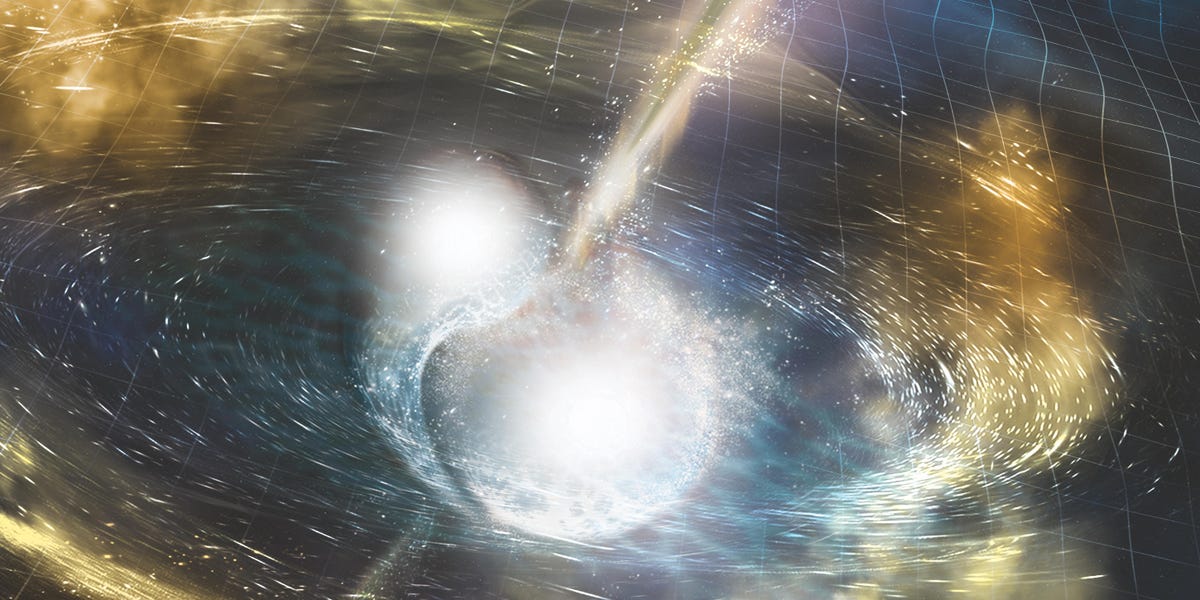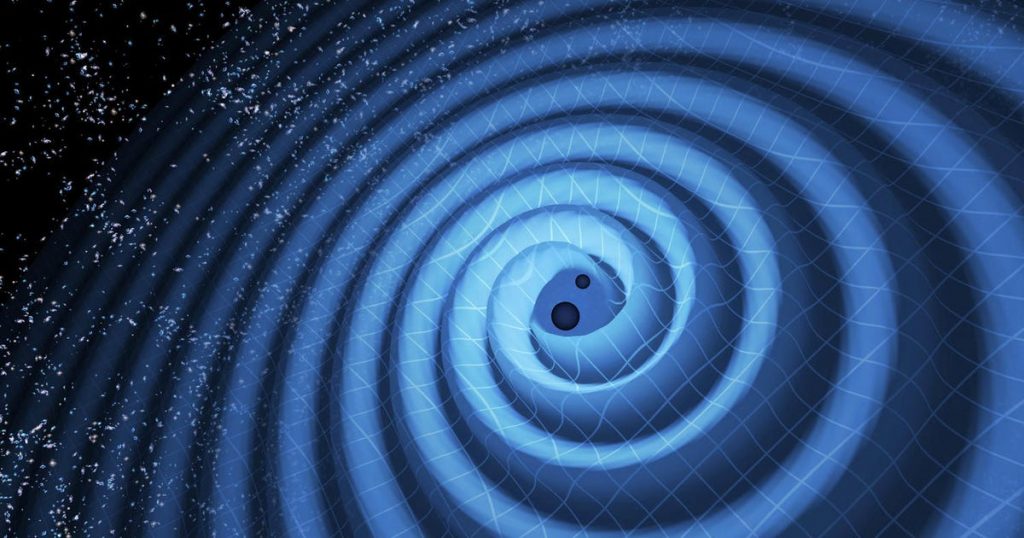Black hole collisions are some of the most intense phenomena in the universe. As the two enormous, invisible bodies spiral toward each and every other, they disturb the fabric of spacetime, sending out ripples throughout the universe. These ripples — gravitational waves — at some point wash in excess of the Earth, wherever some really delicate detectors in the US, Italy and Japan can “hear” them.
1 such ripple washed over our world in the early several hours of Jan. 29, 2020. It was picked up by the dual detectors of the Laser Interferometer Gravitational-Wave Observatory (LIGO) in the US and a third detector, Virgo, in Italy. The detectors’ characteristic chirp prompt a pair of black holes, one particular that was around 40 periods the mass of the sunlight and the other 22 times, experienced smashed together.
In a new research, printed on Wednesday in the journal Nature, researchers examined the wave from this collision, dubbed GW200129, which — when very first discovered — showed a peculiar signal. The wave’s chirp seemed to suggest the black holes that crashed into every single other ended up “wobbling” close to in their orbit. This wobble is, scientifically, known as “precession,” and it would be the to start with time we have observed this impact in black holes.
Having said that, other gravitational wave researchers are not so sure the sign gives proof of this phenomenon. Rather, they have wondered irrespective of whether the knowledge may well be affected by a glitch in one particular of the gravitational wave detectors that very first spotted GW200129.
What is occurring with GW200129?
To start with, let us chat about that “wobble.” To visualize precession, consider of the Earth orbiting the sunshine. You likely consider our small, blue-green planet rotating around the significant, very hot ball of gas on a flat airplane. The earth moves all-around the sunshine devoid of deviating “up” or “down.” It just moves close to the sun like a racecar on the Daytona 500 circuit. (Let us not get into the axial precession of Earth listed here)
In the simulation, you can evidently see the orbital airplane shifting as the two black holes orbit each individual other.
Vijay Varma/Leo Stein/Davide Gerosa.
Two black holes share the exact relationship, rotating close to every single other on a great, flat orbital airplane, shedding energy in the variety of gravitational waves as they circle ever closer to a single a further. But in “precessing” black holes, the orbital plane is distorted more than time. Einstein’s seemingly unbreakable theory of typical relativity indicates the way person black holes spin (certainly, they spin) can impact precession. When the spins are misaligned, the orbital aircraft can be rotated.
You can see an instance of this developed by Vijay Varma, a Caltech astrophysicist, many thanks to a software he made in a 2018 paper in the GIF over.
In principle, astrophysicists can “see” precession in binary black holes by learning the gravitational wave sign, but it can be exceptionally refined. The authors of the new analysis imagine they have captured this elusive indicator in the information — finding a black hole binary that wobbled and tilted all over the area.
“It really is particularly thrilling to have finally observed it,” suggests Mark Hannam, a professor of astrophysics at Cardiff University in the Uk and very first creator on the new analyze. “This is something we have been hoping to observe because the initial detections in 2015, both because it truly is a typical relativity outcome we’ve nonetheless to see in the intense regime of black-hole mergers, and it has the opportunity to tell us a lot about how black holes form.”
Don’t forget I outlined black holes can spin? Nicely, usually, black holes that type when a star collapses spin quite slowly and gradually and devoid of any precession. But black holes that are developed by the formation of two other black holes colliding can have really unusual spins and serious speeds, which could throw the complete program into disarray. Consequently, Hannam notes, “a single possibility is that the greater black hole was manufactured in an previously merger of two black holes.”
Rather extraordinary, but is it circumstance closed? Not so rapid.
Glitch in the house-trix
Nevertheless the sign might be interpreted as a pair of wobbling, precessing black holes, other astrophysicists have observed GW200129 could be a thing much less remarkable: An mistake.
“In the case of GW200129, there was a faint but current glitch in LIGO’s Livingston detector coincident with the event,” said Ethan Payne, an astrophysicist at Caltech. Payne a short while ago authored a preprint report, uploaded to the site arXiv in June, which describes GW200129 as a “curious circumstance” and provides the argument that these a glitch may well be affecting the signal.
Gravitational wave detectors can experience glitches and sounds that from time to time obscure the indicators. Most, Payne said, do not affect our knowledge of in which a gravitational wave originated. With some finessing, experts can account for the sound and glitches. This was the circumstance with the extremely 1st detection of gravitational waves from two colliding neutron stars, but experts have been equipped to design and “subtract” out the glitch.

An artist’s impression of two neutron stars colliding, generating gravitational waves and a massive, bright jet.
Caltech/LIGO
In the case of GW200129, one more sensor in the gravitational wave detector was employed to subtract out the glitch by Hannam in the new examine. “The glitch removal may well not have been fantastic, but it is very unlikely that anything left in excess of could mimic the precession we have viewed,” said Hannam. He says he is assured in his team’s final result simply because of all the advancement that went into preparing the data from the detectors and the checks accomplished on his team’s possess evaluation.
But uncertainty remains. Payne’s get the job done suggests some of the finessing experts have accomplished can take out all proof of the glitch. Other astrophysicists I spoke with propose the analysis have not fully accounted for this.
“I consider it is really interesting get the job done,” explained Eric Thrane, an astrophysicist at Monash University in Australia and member of the LIGO-Virgo collaboration who was not affiliated with the study, “but in light of Payne[‘s paper], I am not sure they have demonstrated what they set out to.”
It really should be pointed out that the system of examining the GW200129 sign, determining its precession, creating the new review and obtaining it acknowledged for publication in Mother nature usually takes a long time. Hannam and his co-authors had been preparing this piece prolonged prior to challenges with the LIGO glitch have been totally settled. The new paper has not talked about issues lifted by the analysis carried out by Payne and his team but Hannam notes “their approach nonetheless demands development.”
This is science in motion. 1 crew explains a info place, one more gives factors why we must be cautious about it. For now, astrophysicists I spoke with seem to be to be leaning away from GW200129 staying the 1st precessing black gap binary we’ve spotted. But it’s only a matter of time prior to experts unequivocally see this phenomenon.
The LIGO, Virgo and Kagra detectors are established to commence another observing operate, the fourth, in early 2023. About the past two several years, the detectors have acquired considerable upgrades which will make them far more delicate, opening up the possibility of detecting even a lot more faint signals from throughout the cosmos. “We are most likely to notice 200 to 300 extra GWs per year, so you will find a good opportunity that we will shortly recognize these programs a great deal greater!” stated Hannam.
And with that appear even further troubles, particularly all around sorting by the glitches and sound.
“As the anticipated amount of observations is heading to boost as our detectors are enhanced, the range of occasions contaminated with glitches will skyrocket, and thorough function will be desired to design the glitches,” said Payne.






More Stories
Reasons Why the Blue Screen of Death Occurs
Door Handle and Hardware Tips
Surviving Missing Futon Frame Hardware Nightmares